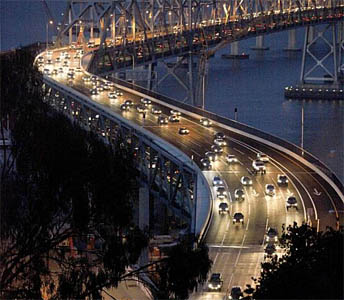
With the Bay Bridge’s new eastern span opening in less than two weeks, Bay Area transit planners discussed looming capacity issues on the bridge and other transbay travel options at a San Francisco Planning and Urban Research Association forum earlier this week.
Sarah Dennis-Phillips from the San Francisco Planning Department discussed at the Thursday lunchtime forum held at SPUR headquarters how job and housing growth in San Francisco and the East Bay by the year 2040 will translate into more people commuting in and out of San Francisco.
“All new workers will not be living in the city,” Dennis-Phillips said. “We have to find a way to get them here.”
With 8,000 new homes and hundreds of thousands of square feet of retail space expected to be built on Treasure Island in the coming decades, she said there will be even more demand to get people into the city via car, public transit, bicycle, ferry or otherwise.
More people coming into and out of San Francisco during peak commute hours in the morning and evening may lead to the Bay Bridge being unable to handle the heavier loads by 2040, said Anthony Bruzzone from Bay Area-based planning firm Arup.
The workforce in San Francisco, according to Bruzzone, consists of 40 percent who live in the city, 40 percent who come in from the East Bay, about 12 percent from the Peninsula and the remaining 8 percent from Marin County and the North Bay.
If that geographic breakdown continues into the coming decades, the capacity to carry people across the Bay will be strained, he said.
There are 190,000 new jobs expected in the city by the year 2040, which is a 30 percent increase from the current total, he said.
He said there are about 75,000 trips made into San Francisco on the Bay Bridge per day, with about half of those trips made during the morning commute.
By 2035, the capacity of the bridge—and other transbay options such as BART—is expected to exceed its limit, especially since there hasn’t been added capacity to the “Bay corridor” since BART opened in 1974, Bruzzone said.
Before that, the Bay Bridge’s conversion into a two-deck bridge in 1963 was the last time more people were able to get across the water.
“We’ve been living off the investments of our grandparents,” Bruzzone said.
Bruzzone said a redesign concept to consider on the Bay Bridge in the coming years is a “contraflow configuration” which would allow certain lanes of traffic on the bridge to switch directions based on need and crowding.
This proposed system would purportedly help alleviate increasing congestion at the toll plaza from more and more cars that will inevitably be driving on the bridge once BART trains become too crowded, he said.
“At some point we run out of ways to get people in and out of town,” Bruzzone said.
With a congested toll plaza, the highway system starts to break down as well, with cars backing onto Oakland freeways, he said.
Ridership levels have been steady on the Bay Bridge in the past 20 years, while BART has carried increasing numbers of riders.
Robert Mitroff, BART’s fleet and capacity manager, said station and platform crowding at San Francisco stations is also a growing worry along with crowded cars as more passengers take to the transit system.
BART has a maximum standard of 107 passengers both standing and sitting in each car. That is a limit BART officials aim to maintain as trains take on more passengers, which tends to slow down the system.
“The more crowded cars are, the longer it takes for people to get off,” Mitroff said.
Based on projections from current figures, by 2030 there will be 134 passengers jammed into BART cars unless new trains are purchased, he said.
There is a demand for more trains but that requires funding to acquire the costly vehicles, he said.
The BART system currently handles 400,000 daily trips through the Transbay Tube and that number is expected to reach 500,000 by around 2020. Once it hits 750,000 daily rides, Mitroff says the transit system will reach its threshold.
Mitroff predicted by 2030, major investments to modify the BART system will need to be made—such as more space on platforms and alternative methods to handle delays at clogged downtown San Francisco stations.
Bicycling could be another option to relieve congestion crossing between the East Bay and San Francisco, but East Bay Bicycle Coalition board member Sandra Hamlat said that travel option is currently non-existent.
The new eastern span of the Bay Bridge that is opening on Sept. 3 has a bike and pedestrian path that will end about two-thirds of the way across to Yerba Buena and Treasure islands.
The bike pathway onto the mid-span islands is expected to be completed by early 2015 once crews take apart and remove a portion of the old eastern span that is currently blocking the path’s access to the islands.
However, the “bicycle pier”—as Hamlat called the bike path – will still not give riders or pedestrians a way to go all the way across the Bay.
There are plans under discussion to continue the path on the western span and into San Francisco, but that project is decades in the making and already facing obstacles, such as how to get bicyclists onto street level once arriving on the San Francisco side, Hamlat said.
“It took years of relentless advocacy … to produce what we have now,” Hamlat said. “It will take a few more years to see the bike path completely extend into San Francisco.”
The entire Bay Bridge will be closed starting 8 p.m. Wednesday and is scheduled to reopen the day after Labor Day at 5 a.m. when the new eastern span—a $6.4 billion project—will officially open.
Sasha Lekach, Bay City News









